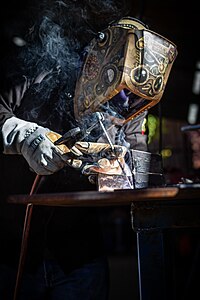
Photo from wikipedia
Abstract Effect of pulsed laser welding parameters (pulse energy and duration, frequency, welding speed and, as a result, overlapping factor) on properties of E110 (Zr-1%Nb) alloy welds is presented. Butt… Click to show full abstract
Abstract Effect of pulsed laser welding parameters (pulse energy and duration, frequency, welding speed and, as a result, overlapping factor) on properties of E110 (Zr-1%Nb) alloy welds is presented. Butt welded joints of two identical plates with a thickness of 0.5 mm were investigated. EDS analysis of a surface layer of the welds was done, initial hydrogen concentration in the weld metal was measured and influence of absorbed gases (oxygen, nitrogen, carbon and hydrogen) on tensile strength, microhardness, hydrogen absorption rate and corrosion resistance of the welds was evaluated. The weld metal contained initial hydrogen concentration within the limits set by standards. However, mixing argon flows with atmospheric gases caused the weld metal contamination with oxygen, nitrogen and carbon. As a result, inclusions of complex chemical composition and surface branching microcracks were formed. They were stress raisers where weld failures occurred. Furthermore, it was the reason of increased hydrogen absorption rate and decreased corrosion resistance of the weld metal. The obtained results showed that absence of discoloration on surfaces of the welded joints did not guarantee metal purity and, as a consequence, required performance properties. Future research is required to determine the optimal overlapping factor; shielding gas compositions (Ar, He or their mixture) and flow rates; configuration and inclination angle of nozzles as well as distance from the nozzles to the weld zone.
Journal Title: Journal of Manufacturing Processes
Year Published: 2019
Link to full text (if available)
Share on Social Media: Sign Up to like & get
recommendations!